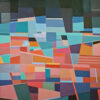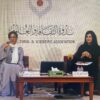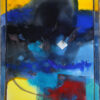Jacques Derrida’s coarse philosophy or difficult method of writing is not the reason for him being challenging. Every diligent and assiduous reader is able to follow the thin and controlling line of Derrida’s thoughts, even if this line could lead him into a maze, yet it guarantees a safe exit. The reason for Derrida’s difficulty isn’t an obstacle of word or phrase but of an inconvenient position he took for himself, one that could be summarized as “in-between”, a phrase that we name of its synonyms: Isthmus, the place in the middle of two places, the grey area, undecidability, perplexity, confusion… etc. when you’re on the side where the Aristotelian law of noncontradiction collapses, when “this” could be mistaken as “that” in a state of confusion or perplexity, then we’re truly in the presence of this awkward or inconvenient state for this law of thought. Derrida was interested in the words that could mean simultaneously the thing and its opposite such as “Pharmakon: meaning both venom and antidote” in ancient Greek, and “Aufhebung: meaning both preserving and transcendence” in German, on the basis of him standing on the edge, in-between, between the solid ground of knowledge which might not be enough to express the depth of the look, and the vast space of the look in which you can fly but requires a solid linguistic ground to encompass it.
In-betweenness: The mirage and the chameleon
Understanding In-betweenness (being in-between) is the foundation for understanding Hauntology, and figuring out the controlling line of Derrida’s scattered thoughts. What he calls “Deconstruction” is no different from “text work” which in itself carries its contradiction and dispersal while he seeks to prove his matters or unveil the consistency of his arguments. Yet reading reveals the opposite to that claim, that the text contains contradictions that formulate its nature, a text that has entangled terms and disputing thoughts. The text in the Latin tongue is textus (texture), and what appears of the texture is the magnificent harmony and what it produces of garments, shirts, and dresses, but on the deeply veiled interior, it has all kinds of entangled threads and intertwined fabrics. The text performs in a way that decentralizes wording and significations, so we do not stop at “this” signification unless it refers to “that” signification which, in turn, refers to other significations, in a circle that depicts the impossibility of capturing the meaning (Gorman, 2015, p.9). When the meaning escapes the attempts to capture it, with its great lightness in mobility and travel, it turns into a trace in the form of a specter or a phantom, this effect is what allows Differance in its encompassing meaning of “deferring” from the origin, while seeking to act as its “successor” the same way the mark leaves a successive trace “it is the origin as non-origin, the origin effaced” (Lucy, 2004, p.145).
The origin is the object that could be traced back without ever finding its truth, following the trace is equal to the mirage which could be perceived but could never be reached, because it is the result of the light and heat, “I have come to realize what does not really exist but only in reference, same as the light shining on earth, same as the chameleon changing its color to match the things”. Looking at a mirage without even grasping its truth introduces an ontological law, different from what philosophy introduced throughout its logical and linguistic history, according to the common metaphysical sayings. We can say that the trace (or, more broadly, the in-between state) belongs to what Ibn Arabi calls “It not it”, the thing that is itself and another simultaneously, even the other at the heart of the thing, or the “the opposite that is contained within its own opposite” (Ibn Arabi, Al Futuhat, 2, Page 605). If that’s the case, then the entanglement between “this” (opposite) and “that” (another opposite) as being its tract is the cause of perplexity and confusion, that confusion in which Al-haqq (The Real) is present everywhere and in everything. (Almond, 2011, page 111)
The Real presents itself in all colors, in a manifestation that is like a chameleon, “no evidence, from the animals, on The Real, is more apparent than the chameleon, no adjective nor a state ever lasts for two times, and no image ever appears twice” (Ibn Arabi, Al-Futuhat, page 500). So if no adjective or a state can be determined, then the matter is considered to have Undecidability, due to the fast-paced images in the world and their confusion, the stand one must take is not knowledge but rather a perplexity. Perplexity from something that is ever turning and spinning is destined to cause one to turn and spin, and in every turn, there is alteration, meaning changing and substitution, so that the things change in their descriptions, yet their real self remains the same. The eye witnesses chameleon changes, where no state or color stays the same, which is the source of confusion and the reason for perplexity, hence the Undecidability, and the Différance (suspense of judgment) in the phenomenological aspect, makes the transformation ontological, and to really know things, epistemologically, simply not possible, this “transformation” is dualistic and perplexed, as it simultaneously means “the impossible” that cannot happen, and the “metamorphous” that is continuously transforming. the undecidability is then this transformation with its dualistic meaning; the impossible and the metamorphous.
Hauntology: The Semiotics of the Metamorphous:
The matter will no longer be difficult to grasp when we see that metamorphosis, in the sense of transformation, is the specialty of alchemy, which in the old times was known to be the science of turning a paltry object into a precious one, and the realistic signification turned into a metaphorical one, one of transforming the human self. The prominent title to ancients was “Alchemy of Happiness” or the way in which man could achieve a radical transformation of himself, one that brings him the happiness he sought. We say in Arabic “سيمياء” or “كيمياء”, the difference here is phonetic but it also has the resemblance in digit pronunciation of S and Sh in Hebrew. Derrida contemplated this resemblance using the word “Schibboleth”, this slight resemblance that shows a radical difference. So if we were to look at the origins of the words “Simiyya” and “Kīmiyāʾ”, between “Sēmeîon” (Sign) and “Kīmiyāʾ” (mix), we realize that the mixes that blend to form a metal or a state, are signs intertwining to form a certain category.
The difference is that Arabs read the “K – ك” as the sound “Kh – خ” in the Greek word, so they read (Khêmeia) instead of (Kīmiyāʾ), and (Khêmeia – Alchemy) for them was the art of turning the paltry to precious, practically by turning metals into gold, or metaphorically turning vices into virtues. It is different with “Semiotics – Simiyya” which is descriptive and interprets signs, such as illness signs, but articulates the metamorphosis, by contemplating the signs of transformation from one state to another, from weakness to strength or vice versa. This correlation in the term “Simiyya” is to be thought of, which is the way the powers merge and result in strange action. (Al Ahmar, 2010, page 31), which was in this initial signification referring to magic and sorcery, but we shall focus here on the framing concept of it, which is metamorphosis, rather than the superstitious one. In the superstitious concept, we can always say that magic and sorcery work on soul summoning, with delusion and diversion, same as the metal that transforms into gold, but it never is, and never was, gold.
The term “bewitched silver” means to plate it with gold. But the souls that manifest which we call phantoms or specters, are not the myth we think they are. Specters are not the spirits of the dead, which are called “Eidolon”, and they are not transparent kind beings, good or evil, as the ones featured in horror movies. The specters are another name for “in-betweenness”, being simultaneously present and absent, or being present to absence, “the specter is a paradoxical incorporation, the becoming-body, a certain phenomenal and carnal form of the spirit.” (Derrida, 1993, page 25). With this definition, Derrida introduces how a specter is undecidable: it is neither soul nor body, it is the middle ground between two truths, one that is materialistic, and another that is not-materialistic, and incorporation differs from embodiment, so we might say “the soul is incarnated” but we might not say it is embodied.
The Specter and the Resemblance: Perplexity and Confusion
To Derrida, cinema is a specter-producing machine, because the in-betweenness of the specter is contradictory in borders: we see someone who is dead, yet alive in the cinematic film, we see him after he passed away, it is him, yet it is not him. He’s the absence (the past) in the presence (the present). The Specter is the resemblance “as though it were the very same”. This is the source of confusion for the Queen of Sheba between the throne that is present before her eyes and the absent one, her real throne: “So when she came, it was said (to her): “Is your throne like this?” She said: “(It is) as though it were the very same.” (Surah An-Naml – 42). So the phantom disappears in its presence “as though it were the very same”, as though the phantom is the person, yet it is not he. The body in which it resides is not the same sensible materialistic body. It is a specter “the specter, same as a rainbow is multiple and varied in color, leaves us with feelings of bewilderment and astonishment, or deceive and deception. The specter does not dwell, as it is always moving and transitioning, same as the shadow of a man that stretches and shrinks as the time passes, from morning to the noon, to the evening till the sun sets” (Bekkaye, 2011, page 127)
The specter inspires illusions and stirs a feeling of being astray, similar to the images seen while sleeping, which feels real, yet they’re the product of exhilarating glimpses of the mind, or those seen by the audience in cinema as though they’re real, yet they’re the product of special effects fabricated by the computers. These increasing, multiplying, and frequenting images give the impression that the scene is real, while it is imagined (for the sleeper) or virtual (for the viewer). It is as if this formula is a reminder of the Baroque principle that existence is fictional, “Life is a Dream”, according to the Spanish writer Pedro Calderón de la Barca, or “The Great Theatre of the World”, where everyone of us is an “actor” in his life, just as the actor who manages to combine the apparent contradiction between absence and presence, where he represents absence (an ancient person) in his present play, or “an imagination within an imagination” to use Ibn Arabi words, the “imagination” of acting (representing the departed person, when he’s not him) and the “imagination” of reference (since it is just a play, that has nothing to do with reality).
According to the linguistic root itself, representation is the act described as invoking the absent, so the absent is “represented” in the mind (the imagination) or in the machine (the cinematic film) so much like the accused is represented in front of the court, so the “representation” of the absent is the presence on his behalf, hence the actor (on theatre or in cinema) attendance on his behalf. Representation is what always returns in a different or altered form, every time. The actor plays roles of an event that is occurring in frequent versions, he is himself, every time, yet he’s not, he has an alternative self, and he has a deferred real-self behind. The specter returns in varied forms: “the return – Awda” meaning coming back in a new form, “the festival – the Eid” meaning to celebrate someone or some event which requires the spectral return of that person or event, “the habit – Al Aada” meaning the traditions and rituals that are repeated so the action becomes a lasting impression, or the culture becomes a second nature, because what is repeated tends to last, hence achieving that “in-betweenness”, in the
sense that repeating is the continuous return, and in the sense of consistency of that repeated return becoming a fixed event reoccurring periodically.
Signaling between Suggestion and Declaration: Towards a philosophy of in-betweenness
The return of the ghosts is the prominent theme of the age, in the different seasonal festivals, in the technical and cinematic products, and in financial and digital trading, “The body of money is but a shadow” according to Marx (Derrida, 1993, p.80), so what we exchange and is repeated in the system of trading and exchanging is an illusion or a specter, in the sense that money is here on behalf of some other metamorphous which equals the exchanging value, and in the sense that money itself is absent, it disappears and its presence is achieved via other alternatives like cards, bank transfers, and cryptocurrencies such as “bitcoin”. The materialistic has vanished into the virtual by acquiring a “light body” instead of the “thick body” (which is paper or metal). So, it looks thick in spite of its lightness, because the thick is what can be touched, while the light is what is seen but cannot be touched, or cannot be seen yet it could be felt. The spirit and the ghost, who share a mutual root, have this reversible quality in the untouched seen appearance of a Ghost and the conceived unapparent presence of a Giest.




The German word Giest, meaning spirit, is the term that achieves this sought in-betweenness, because “Al-Rouh – الروح” in Arabic or the Latin synonyms in English and French are meant for an invisible transparent entity, while the German word Giest refers to the transparent and the thick simultaneously. A metaphor of utmost eloquence is one by poet Johann Goethe who describes the spirit by saying it resembles sea foam, the sea foam has both the dense quality of foam and the transparency of water, both seen and unseen at the same time, at one hand the white foam and at another the transparent water. When we speak of the soul of the worlds, or the soul of the world “I saw the emperor – this soul of the world, seated on a horse” said Hegel about Emperor Napoleon while leaving Jena, the German city, in a letter to his friend Friedrich Niethammer on October 13th, 1806. This soul is when we speak of an Isthmus that represents something, located within the “in-betweenness” law of humanity, “between” the thick density of a real human being (Napoleon) and the lightness of a transcendent human being (the soul of this world): according to Derrida, “the spiritualization produces a specter” (Derrida, 1993, p.203), but no spiritualization without a body, and the body is not the human body: “The apparition form, the phenomenal body of the spirit, that is the definition of the specter” (Derrida, 1993, p.216).
Just as the ghost incarnated appearance has an ontological justification, the spectral linguistic appearance has a philosophical one. The Hauntology of the language lies in this signaling that sways between suggesting and declaring, or the trajectory between the sign that suggests and the statement that declares. This signaling has a matter of secrecy or one at heart, so the word “to make a gesture – لاح” has this quality of being ambiguous, something that is not steady, and all that appears to of it can be comprehended by guessing and working on a hunch. Also, “to signal – لوّح”, is to shine or beam, like the mirage seen from far “which a thirsty one thinks is water” (Surah An-Nur – 39). The action of manifestation is foamy, because it is a transparent matter manifested in a thick one due to the waves colliding and crashing. Also, in Arabic, the root of the word “لوّح – signal” has a relative mirrored root which is “حوّل – transform” which says something about changing, transitioning, and capability. The apparent meaning on the surface of the language cannot be a sign that suggests, which is an inner element, or a statement that declares, which is an outer element. This linguistic signaling is the same as the suggestive transformation via referencing and transcendence; to defer, to adjourn, and to deliberate. This signaled meaning is some kind of deferring and hoping, because it is a world filled with the possible, probable, and the unanticipated.
The secret and the signal: The Self and the Other
Signaling meaning lies deep within the law of the secret, that a sign only suggests and disguises, while a statement declares and publicizes. There is a mild parting between signaling and suggesting, it is one soft delicate difference. In Arabic “الستر – disguise” contains the “السر – secret”, yet the secret alone has a system of spiritualizing the body of the language, what is apparent amidst its absence or the opposite, what is absent amidst its appearance, while the disguised remains hidden and the sign remains veiled. Why the secret? Because it is the only identity that opens a window from within its closed world, something like the Monads (Monadology) of Leibniz. The secret opens, from within its internal condition, a window on the other, “The Other is a secret because it is other than the Self” (Derrida), which is simultaneously apparent in his figure, actions, and features, and hidden with his secrets, notions, purposes, and intentions. Yet, where signaling lies in The Other is in what we call lineaments, meaning the forehead lines and facial features, which foretell the emotional states such as happiness or sadness. Deconstruction is nothing but the possibility of the secret as an experience, which has nothing to say” (Derrida, 2003, p.27), but has a lot to do.
The secret is an experience is not the same as all experiences, it is an in-between experience, between concealing and declaring, by placing one amidst the other, to appear amidst absence and the opposite. The Self is like The Other and its peer, but the self is not “similar” to the other unless it witnesses his experiences, sees his struggles, and empathizes with his tragedies. This is because humans, when it comes to emotions at heart, are peers and equals, and so is the mutual sympathy among humans: what I allow for myself, I allow for others. The most profound example of such allowing and is one of Gadamer: “You should always take into consideration the possibility that the other is right, this is the spirit of interpretation” (from a lecture at Heidelberg University, July 9, 1989). To experience the secret is to empathize with this universal dimension “monads” that ties humans together in an articulate rhythm or a pleasant symphony, because the secret is the embodiment of a mutual spirit of dialogue and tolerance, something that Gadamer has described as the spirit of interpretation itself, as long as the understanding, on which the Interpretivism is founded, has at its core, a spirit of agreement.
For that, the experience of the secret or the system of signaling is what makes this philosophical dialogue possible. The sign represents the concealed and the statement represents the unveiled appearance. The former takes the self away and flees to its own world, and the latter overpowers with what it has to say, so it crosses its borders, in conflict and in dissonance. The signaling alone is what could transform the system of relationships among humans, and philosophy, in the end, and after revolving around all these specters, is but the transformation that each one of us makes himself, like the Semiotics in transformation and chemistry towards happiness, in the form of “Spiritual exercises” (Hadot, 1995, p.80) which are enough to connect the person to his self in configuration, and takes him outside the borders, outside the self, to overcome his others, egocentrism and ego, or serenity and distinction. the secret, as an experience, is the philosophy of in-betweenness that teaches the person how to live as a “medium”, to facilitate relations and simplify ties, and connect the worlds, for a mutual life in which “The other could be right”, which is the ultimate philosophy of tolerance and the Semiotics of hauntology: the specter is not the appearance that voices terror, but what appears to be a spirit that transcends all that is coarse and rude, one that is modest and disguised while simultaneously being transcendent the sublime.

References
- Al-Ahmar, Faisal (2010), Dictionary of Semiotics, Arab Scientific Publishers and Ekhtelaf Publications, Beirut-Algeria, 1st edition. (Source in Arabic)
- Ibn Arabi, Muḥyī ad-Dīn (n.d.), Futūḥāt al-Makkiyya (Meccan Revelations), Dar Sadir Publisher, Beirut, (In Arabic)
- Almond Ian. 2004. Sufism and Deconstruction : A Comparative Study of Derrida and Ibn ʻarabi. London: Routledge.
- Bekkaye, Mohamed (2011), “The Hauntology Statement in Jacques Derrida”, Jacques Derrida: What is now? What about Tomorrow?, supervised by Mohammed Chaouki Zine, Al-Farabi publication house and Ekhtelaf Publications, Beirut-Algeria, 1st edition. (Source in Arabic)
- Derrida, Jacques (1993), Spectres de Marx. L’État de la dette, le travail du deuil et la nouvelle Internationale, Paris, Galilée.
- Derrida, Jacques (2003), Genèse, généalogies, genres et le génie. Les secrets de l’archive, Paris, Galilée.
- Hadot, Pierre (1995), Philosophy as a Way of Life. Spiritual Exercises from Socrates to Foucault, Trans. Michael Chase, Introduction by Arnold I. Davidson, Blackwell: Oxford-Melden.
- Lucy, Niall (2004), A Derrida Dictionary, Blackwell Publishing: Oxford-Melden.
- Gorman, Clare (2015), The Undecidable: Jacques Derrida and Paul Howard, Cambridge Scholars Publishing: Newcasle (UK).
Researcher, professor of philosophy at the University of Tlemcen (Algeria). Ph.D. in Arabic and Islamic Research and Study/ Mysticism and Interpretations, University of Provence (France) 2004, Ph.D. degree in Philosophy from Aix-Marseille University (France) in 2011 in the field of Practical Philosophy and Le quotidian.








